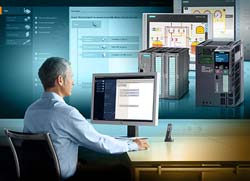Siemens introduces TIA Portal – a new software engineering framework, as the building block for modern automation and drive tech

The new software engineering framework enables users to develop and commission automation systems quickly and intuitively, which eliminates the traditional time consuming and costly integration of separate software packages. Designed for high efficiency and user-friendliness, the TIA Portal is suitable for both first-time users and experienced users.
Furthermore, the TIA Portal will be the basis of all future software engineering packages for configuring, programming and commissioning automation and drives products in the Totally Integrated Automation portfolio from Siemens. Examples of this include the new Simatic Step 7 V11 automation software for Simatic controllers, and Simatic WinCC V11 for Simatic HMI (human machine interface) and process visualization applications.
For the design of the TIA Portal framework, Siemens studied many typical software engineering applications over several years and analyzed and evaluated its customer requirements worldwide. As an integral component of all software engineering packages from Siemens, the TIA Portal framework provides advanced shared services across all the configuration interfaces ensuring uniform navigation for the user and consistent system behavior. For example, all devices and networks in any automation system can now be configured within one shared device and network editor. Project navigation, library concepts, data management, project storage, diagnostics and online functions are standard features and made available to the user in the shared TIA Portal framework. This unified software development environment offers a high level of efficiency across the overall automation project and is comprised of programmable controllers, HMI devices and drives. Additionally, all data management for controller parameters, blocks, tags or messages now only need to be entered once, saving significant time and cost for software engineering of an automation project. The design of TIA Portal is based on advanced object-oriented software architecture and centralized data management, providing seamless data consistency by automatically avoiding data entry errors. Users can easily find data and program blocks across the entire automation project using a project-wide cross-reference system, which greatly reduces the time to troubleshoot and debug a typical software project.
This new single software framework will enable all Siemens Programmable Controllers, HMI operator panels and drives to be configured in the same development environment. This greatly reduces interfacing and configuration costs, for the common tasks of communications setup between controllers, drives and HMI devices. For example, the user simply drags and drops a tag from the programmable controller, such as the signal of an I/O (input/output) module, to the screen of an HMI device. The tag is instantly assigned within the HMI, and a controller-HMI connection is created automatically in the background with no manual configuration required.
The new Simatic Step 7 V11 engineering software, based on the TIA Portal framework, supports Simatic S7-1200 controllers, all the Simatic S7-300 and S7-400 controllers, and the PC-based automation system Simatic WinAC. Supporting this wide range of programmable controllers enables Simatic Step 7 V11 to provide the most scalable software engineering capabilities and performance requirements for an automation system. Benefits of this scalability includes transferring existing configurations of Simatic controllers and HMI devices to new software projects and greatly reducing the time and cost of typical software migration tasks.
The new Simatic WinCC V11 engineering software is also based on the new TIA Portal framework. This includes configuration of machine-level applications using HMI operator panels with support for current Simatic TP and MP model panels, support for the new Simatic HMI Comfort Panels, and for larger PC-based SCADA (Supervisory Control and Data Acquisition) process visualization systems. Configuration and commissioning of the Sinamics inverter drive family is planned in future TIA Portal enhancements.
The Siemens Industry Sector (Erlangen, Germany) is the world's leading supplier of environmentally friendly production, transportation, building and lighting technologies. With integrated automation technologies and comprehensive industry-specific solutions, Siemens increases the productivity, efficiency and flexibility of its customers in the fields of industry and infrastructure. The Sector consists of six Divisions: Building Technologies, Drive Technologies, Industry Automation, Industry Solutions, Mobility and Osram. With around 207,000 employees worldwide Siemens Industry posted sales of about EUR35 billion in fiscal year 2009.http://www.siemens.com/industry
The Siemens Industry Automation Division (Nuremberg, Germany) is a global leader in the fields of automation systems, industrial controls and industrial software. Its portfolio ranges from standard products for the manufacturing and process industries to solutions for whole industrial sectors that encompass the automation of entire automobile production facilities and chemical plants. As a leading software supplier, Industry Automation optimizes the entire value added chain of manufacturers – from product design and development to production, sales and a wide range of maintenance services. With around 39,000 employees worldwide (September 30), Siemens Industry Automation achieved sales of €7.0 billion in fiscal year 2009.www.siemens.com/industryautomation
Reference Number: IIA2010112500e
Media Contact
More Information:
http://www.siemens.com/tia-portalAll latest news from the category: Machine Engineering
Machine engineering is one of Germany’s key industries. The importance of this segment has led to the creation of new university degree programs in fields such as production and logistics, process engineering, vehicle/automotive engineering, production engineering and aerospace engineering among others.
innovations-report offers informative reports and articles covering technologies such as automation, motion, power train, energy, conveyor, plastics, lightweight construction, logistics/warehousing, measurement systems, machine tools and control engineering.
Newest articles

Innovative 3D printed scaffolds offer new hope for bone healing
Researchers at the Institute for Bioengineering of Catalonia have developed novel 3D printed PLA-CaP scaffolds that promote blood vessel formation, ensuring better healing and regeneration of bone tissue. Bone is…

The surprising role of gut infection in Alzheimer’s disease
ASU- and Banner Alzheimer’s Institute-led study implicates link between a common virus and the disease, which travels from the gut to the brain and may be a target for antiviral…

Molecular gardening: New enzymes discovered for protein modification pruning
How deubiquitinases USP53 and USP54 cleave long polyubiquitin chains and how the former is linked to liver disease in children. Deubiquitinases (DUBs) are enzymes used by cells to trim protein…



